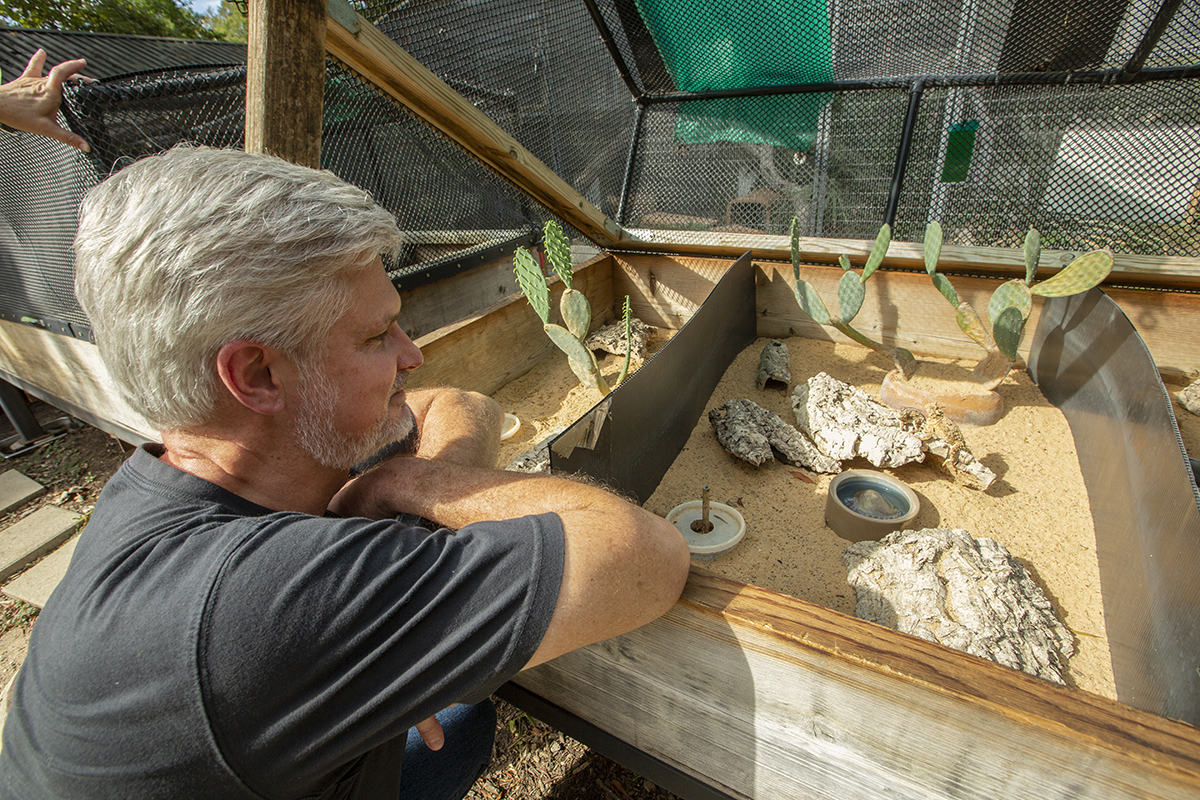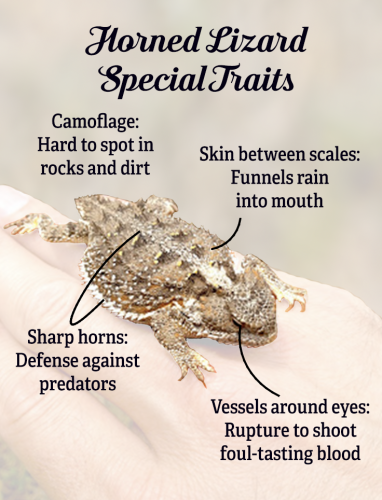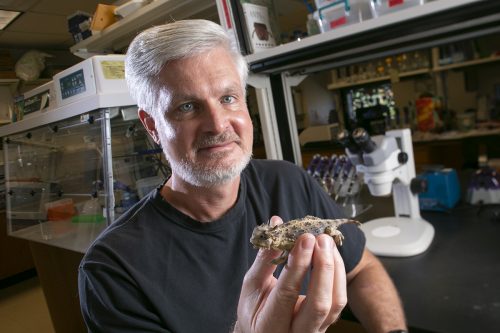
Dean Williams, professor of biology, has been conducting statewide genetics studies on horned lizards and is helping zoos determine the origins of theirs. Photo by Rodger Mallison
Saving Horned Frogs From Extinction
Genetics expert Dean Williams is aiding the lizards’ reintroduction to Texas wildlands.
The August before her senior year and on a whim, Rachel Alenius ’16 (MS ’18) joined a friend on a trip to Kenedy, Texas, to catch horned lizards.
With a round, froglike body, the Texas horned lizard (Phrynosoma cornutum) is commonly known as a horny toad — or among TCU fans, a horned frog. Alenius had never seen a horned lizard outside of a zoo until she arrived in Kenedy, about 60 miles southeast of San Antonio.
Under the direction of Dean Williams, professor of biology, Alenius and her cohorts were helping the TCU Horny Toad Project on a study of the reptiles in Karnes County. The aim of the study is to understand how the lizards can coexist with people.
Additionally, Williams has been conducting statewide genetics studies on the lizards and is helping zoos determine the origins of theirs. The information aids the Texas Parks and Wildlife Department in reintroducing lizards to the wild. The goal is to breed hundreds of the horned lizards in captivity and release them into areas where they once flourished. So far, prospects for survival look promising.
“Since the 1960s, horned lizard populations have been declining and have disappeared pretty much east of Interstate 35, and then there are lots of areas on the west side of I-35 where they’ve winked out — I mean total extinctions,” Williams said.
“There are lots of areas on the west side of I-35 [in Texas] where they’ve winked out — I mean total extinctions.”
Dean Williams
Most extinctions, Williams said, aren’t attributable to a single cause. In the case of the Texas horned lizard, researchers point to urbanization and agriculture, which have transformed the dry, scrubby landscapes where the lizards thrive. Invasive fire ants bear part of the blame.
“Fire ants are native to South America, and they’re far more aggressive than other ant species,” Williams said. “They’ll eat hatchling lizards, and then the insecticides used to kill the fire ants have all but eliminated [the horned lizard’s] main food source — harvester ants — from many urban and suburban areas.”
Delving into DNA
In 2009, Williams began surveying horned lizards using DNA samples collected and preserved by volunteers across the state. Collection kits containing small cotton swabs were mailed to willing participants — willing, that is, to insert a swab into the cloaca of a horned lizard, procuring cells from its intestinal lining. Back in the lab at TCU, Williams extracted the samples’ DNA and sequenced parts of the genomes of individual reptiles. The samples helped Williams create something like a genetic map of horned lizards across Texas.

Professor Dean Williams said the decline in Texas horned lizard populations can be attributed to urbanization, agriculture and fire ants. Photo by Rodger Mallison
“When you’re thinking about starting a reintroduction project, one of the pieces of information you need to have is how the species is genetically structured naturally,” Williams said. “You don’t want to mix populations that are really different from each other genetically.”
Two animals of the same species may not appear different, but their DNA might indicate a historical split, often caused by some geographic barrier such as a large lake or mountain range.
Horned lizards from the western and eastern borders of Williams’ genetic survey area “are different enough in their DNA sequences that they have probably been separated for a very long time,” he said. “This means they had not been breeding with each other for a long time, and so the DNA of the eastern and western groups built up different mutations.”
The split between eastern and western lizards may have been caused by the presence of a large lake that once existed in far west Texas and New Mexico.
“This lake would have confined the western group to New Mexico and the eastern group to Texas,” Williams said. “Once the lake drained, the western lizards probably spread eastward before meeting back up with the eastern lizards in Brewster County, Texas [in the Big Bend area], where we can see they have been breeding together for some time.”
But such an ancestral reunion isn’t always so successful, as populations of lizards may wind up on very different genetic trajectories.
“If you put them back together,” Williams said, “sometimes that can lead to what’s called outbreeding depression, in which the offspring of these hybrids don’t do as well as if they have been purebred because now you’ve messed up the genetic adaptations that a population had to its environment.”
Playing Matchmaker
These kind of granular findings from Williams’ lab help Diane Barber, curator of ectotherms at the Fort Worth Zoo, and her counterparts at the Dallas Zoo and San Antonio Zoo play matchmaker for captive horned lizards.
“His work has been invaluable in helping decide which lizards to breed together to retain positive genetic diversity and making sure the hatchlings are released to the regions for which they’re best adapted,” Alenius said.
Alenius met Williams on her 2015 trip to Kenedy. He was interested in the fact that horned lizards occur at higher-than-normal densities in Kenedy and nearby Karnes City even though harvester ant populations were not plentiful enough to feed the horned lizards.
“Since they couldn’t just be eating harvester ants,” Alenius said, “Dr. Williams suggested that I find out what else they are eating.”
She collected lizard feces and brought the samples back to TCU. After hours looking into a microscope, she noticed tiny fragments of exoskeletons in the feces — those of a specific type of termite found only in South and Central Texas and Mexico. Without their favorite food, the horned lizards had adapted.
Her undergraduate thesis on the diets of the Kenedy-area horned lizards served as a springboard for master’s research and now for a doctoral program.
“I love these creatures so much,” she said. “Aside from them being TCU’s mascot, you can hold them. They just sit in your hand, they’re round — they’re so awkward and adorable at the same time.”
Beloved Cause
Alenius isn’t alone in her affinity for these famed critters. Texans of the baby boomer generation recall keeping horned lizards as pets, perhaps selling them to friends for nickels. Their popularity among native Texans gives the Fort Worth Zoo’s Barber hope that the reintroduction program will succeed.
“It’s truly amazing to me how many people are supporting this. In my business, it’s a rarity,” Barber said. “Usually people are calling me and asking how to get rid of creepy-crawly things on their property. Now I have people calling and asking how to bring these lizards back.”
“Usually people are calling me and asking how to get rid of creepy-crawly things on their property. Now I have people calling and asking how to bring these lizards back.”
Diane Barber
In addition to optimal genetic diversity, Barber said she must also consider the bottom line. After hatching, the horned lizards, not much larger than a thumbnail, begin to feed on termites.
“The termites cost 14 cents each,” she said. “So we’re looking at $27 per week per horned lizard we raise. Ideally, we’re reintroducing large quantities of animals in the wild to stay ahead of predators, but on my end, I’m looking at whether we have enough resources to feed these animals. Then what about staffing? What about veterinary care? Do we have the physical space?”
Costs like these apply to any breeding and reintroduction program, and despite any accounting-related stress, Barber said prospects seem strong for the beloved horny toads.
“Sometimes conservation groups come to us in the eleventh hour when there are 20 of a certain species left in the wild,” Barber said. “With the Texas horned lizards, we have some latitude to apply various breeding and reintroduction methods. And it’s amazing how people care for them and want to see them thrive, whereas a lot of other species just don’t have that. I think that’s what’s truly unique.”

Graphic by Trisha Spence | TCU Magazine archive photo
Williams, who began his career studying Central American birds, admits his own fondness for Texas’ official state reptile. He cites several unique adaptations, including the ability to shoot a stream of foul-tasting blood from ruptured vessels around their eyes.
That and their sharp horns are “their only real defense against aggressive, usually canine predators,” Williams said. “And their ability to virtually disappear is truly amazing. You can radio-track them down to an area like the size of a large desk, and it can still take 15 minutes to find one in that practical area.”
Then there is the rain harvesting “in the skin between their scales,” he said. “They have these nanochannels that funnel water to their mouths, where they can then swallow it. It’s just another cool adaptation to such hot and dry surroundings.”
Hatch and Release
In September 2018, Barber and staff from the Texas Parks and Wildlife Department and the Dallas Zoo released 140 hatchlings at the Mason Mountain Wildlife Management Area, just west of Llano in the Texas Hill Country. Barber and Nathan Rains, a wildlife biologist with Texas Parks and Wildlife, held back 10 baby lizards long enough to glue tiny, lightweight tracking devices to their backs. Using harmonic radar, officials at the Mason Mountain Wildlife Management Area have been able to check in on the little guys since their release.
“We were able to find three or four of the 10,” she said. The next year, they released a total of 107 lizards, which included the Dallas Zoo’s offspring. “We tagged 25 with the harmonic radar tags, and they started scampering and feeding once they were released.”
Readers can find updates on the tagged lizards at the Kerr and Mason Mountain Wildlife Management Area Facebook page.
Williams has been making trips to Karnes City and Kenedy every summer since 2013. There, he has been applying his genetics research to a couple of pet mysteries in these small towns.
“We’ve been interested in how the lizards are able to persist in some of these towns with populations of around 3,000 people, whereas in larger towns they have disappeared,” Williams said. “In some areas of town, they actually occur at much higher densities than they do naturally, and that’s weird. How are they able to avoid predators in these areas?”

Dean Williams studies horned lizards and is working to reintroduce them back into the wild. Williams is shown here holding a life-size model of a horned lizard. Photo by Rodger Mallison
He is also investigating how best to ensure long-term, optimal genetic diversity at release sites such as Mason Mountain, where there aren’t necessarily neighboring wild populations of horned lizards.
“I’m looking at how many individuals need to be reintroduced, and also how often do those need to be supplemented with more in order to make sure that the reintroduced population doesn’t become an inbred lizard island.”
Texas Parks and Wildlife — especially through a conservation license-plate program — along with grants from the Andrews Institute of Mathematics & Science Education at TCU and the TCU Research and Creative Activities Fund have supported Williams’ research.
“When people buy these conservation license plates through the Texas Parks and Wildlife Department, the money goes toward protecting nongame wildlife,” Williams said. “They have supported our work since 2009, and they have also supported some of the reintroduction efforts.”
Williams expects his work to yield as many new questions as answers. He does enjoy one certainty: Texans love their horned frogs.
“We’ve talked to a lot of older people in Kenedy, and consistently horned lizards are this memory of their childhood,” Williams said. “The horned lizard is very much a symbol of Texas. Like bluebonnets. There’s just a lot of enthusiasm for what we’re doing.”

Your comments are welcome
3 Comments
When we lived in SLC UT there was a story posted in the newspaper that when the mormons do the wagon trail of their way of ending up in SLC the kids along the way would have contest to see who could find the most “horny toads”
Growing up in OK we did see them all the time as kids an now I have never seen one in over 40+yrs
So when I read the story I felt so sad for them…one would think that their parents would of told their kids they were on the verge of extinction.
I want to praise the efforts of all those who have given their time, funds, and emotions to this cause. I know how to put those critters to sleep. I played with them all my childhood. I’ve only seen them shoot blood from their eyes once in so those years. I grew up in Van Horn and Odessa and those “to me” helpless guys were everywhere. I was so sad when I first heard they were thought to be extinct. I could not believe it. Since my teens I had been living in the east Texas and Tennessee and never gave a thought about them being in trouble. Thank you people so much cause I just love those lizards.
I had contacted the San Antonio zoo to become part of their release program but they do not go North of the Colorado River. If you are interested in releasing more, I have acreage south of the Coleman area that is on a wildlife exemption. There is a large red ant population on the property as well as termites.
Related reading:
Mem’ries Sweet
It’s a boy. It’s a dog. It’s SuperFrog!
Over the course of a century, the TCU mascot has varied in design and species.
Features
Habitat inventions at Fort Worth Zoo
Science meets art in a new interdisciplinary course designed to boost animal activity at the Fort Worth Zoo.
Features
Discovering Global Citizenship, or How to Help a Vanishing Species
TCU’s award-winning international education program is making an impact on South Africa’s endangered rhinos.